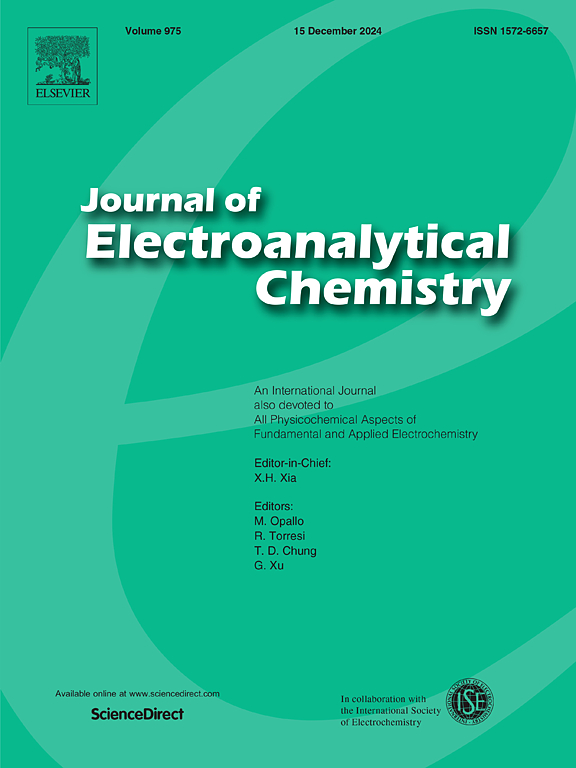Development of a glucose/tartaric acid/glycerol based ternary natural deep eutectic solvent modified carbon paste electrode for carbendazim sensing
IF 4.1
3区 化学
Q1 CHEMISTRY, ANALYTICAL
引用次数: 0
Abstract
In this work, a novel electrochemical sensor based on a ternary natural deep eutectic solvent (t_NADES) modified carbon paste electrode was developed to quantify carbendazim in tap water samples. Ternary NADES (t_NADES) were prepared from D (+) glucose, L (+) tartaric acid as a base binary mixture with ethylene glycol (t_NADES1), glycerol (t_NADES2) or water (t_NADES3) as a third component. When characterized by FTIR-ATR, all t_NADES presented shifts at C![]() O stretching wavenumber confirming the new formed hydrogen bonds interactions. The carbon paste electrode modified with t_NADES2–10%, D(+) glucose: L(+) tartaric acid: glycerol molar ratio (1:1:5) presented the best performance among all t_NADES evaluated due to increased cohesion of the graphitic sheets of t_NADES observed at SEM-FEG images. The addition of t_NADES to the carbon paste also reduces the hydrophobic character of the CPEs. The t_NADES modified electrode presented higher peak currents for both electrochemical probe and carbendazim and lower charge transfer resistance when compared to the bare electrode. The calibration curve for carbendazim presented linear correlation in the concentration range from 1.0 to 15.0 μmol L−1, with LOD of 0.57 μmol L−1. The proposed method proved to be accurate and selective, as observed from intra-day repeatability studies (RSD < 5 %) and the reproducibility of electrode preparation (RSD <5 %). The modified electrode allowed a very accurate recovery for carbendazim in tap water samples, with recovery values between 99.2 % and 101.9 %/ (n = 3).
O stretching wavenumber confirming the new formed hydrogen bonds interactions. The carbon paste electrode modified with t_NADES2–10%, D(+) glucose: L(+) tartaric acid: glycerol molar ratio (1:1:5) presented the best performance among all t_NADES evaluated due to increased cohesion of the graphitic sheets of t_NADES observed at SEM-FEG images. The addition of t_NADES to the carbon paste also reduces the hydrophobic character of the CPEs. The t_NADES modified electrode presented higher peak currents for both electrochemical probe and carbendazim and lower charge transfer resistance when compared to the bare electrode. The calibration curve for carbendazim presented linear correlation in the concentration range from 1.0 to 15.0 μmol L−1, with LOD of 0.57 μmol L−1. The proposed method proved to be accurate and selective, as observed from intra-day repeatability studies (RSD < 5 %) and the reproducibility of electrode preparation (RSD <5 %). The modified electrode allowed a very accurate recovery for carbendazim in tap water samples, with recovery values between 99.2 % and 101.9 %/ (n = 3).
葡萄糖/酒石酸/甘油基三元天然深共熔溶剂修饰碳糊电极的研制
在这项工作中,开发了一种基于三元天然深共晶溶剂(t_NADES)修饰碳糊电极的新型电化学传感器,用于定量自来水样品中的多菌灵。以D(+)葡萄糖、L(+)酒石酸为基料二元混合物,以乙二醇(t_NADES1)、甘油(t_NADES2)或水(t_NADES3)为第三组分制备三元NADES (t_NADES)。通过FTIR-ATR表征,所有t_NADES均出现CO伸展波数的移位,证实了新形成的氢键相互作用。在所有的t_NADES中,经D(+)葡萄糖:L(+)酒石酸:甘油摩尔比(1:1:5)修饰的碳糊电极表现出最好的性能,这是因为在SEM-FEG图像中观察到t_NADES石墨片的内聚性增加。在碳糊中加入t_NADES也降低了cpe的疏水性。与裸电极相比,t_NADES修饰电极对电化学探针和多菌肼均具有更高的峰值电流和更低的电荷转移电阻。多菌灵在1.0 ~ 15.0 μmol L−1范围内呈线性相关,检出限为0.57 μmol L−1。从日内重复性研究(RSD <;5%)和电极制备的重现性(RSD < 5%)。该电极对自来水样品中多菌灵的回收率非常精确,回收率在99.2% ~ 101.9% / (n = 3)之间。
本文章由计算机程序翻译,如有差异,请以英文原文为准。
求助全文
约1分钟内获得全文
求助全文
来源期刊
CiteScore
7.80
自引率
6.70%
发文量
912
审稿时长
2.4 months
期刊介绍:
The Journal of Electroanalytical Chemistry is the foremost international journal devoted to the interdisciplinary subject of electrochemistry in all its aspects, theoretical as well as applied.
Electrochemistry is a wide ranging area that is in a state of continuous evolution. Rather than compiling a long list of topics covered by the Journal, the editors would like to draw particular attention to the key issues of novelty, topicality and quality. Papers should present new and interesting electrochemical science in a way that is accessible to the reader. The presentation and discussion should be at a level that is consistent with the international status of the Journal. Reports describing the application of well-established techniques to problems that are essentially technical will not be accepted. Similarly, papers that report observations but fail to provide adequate interpretation will be rejected by the Editors. Papers dealing with technical electrochemistry should be submitted to other specialist journals unless the authors can show that their work provides substantially new insights into electrochemical processes.

 求助内容:
求助内容: 应助结果提醒方式:
应助结果提醒方式:


